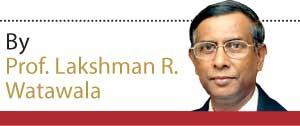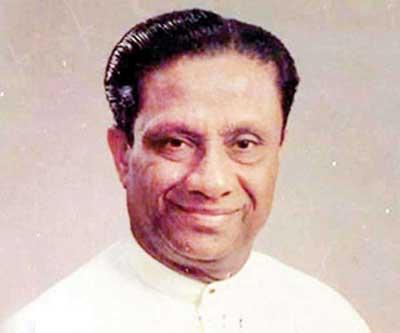Reply To:
Name - Reply Comment
200 Garment Factories Programme - the major foreign exchange earner for Sri Lanka
Success factors
On the 30th death anniversary of President Premadasa we should recognise the major contribution made to the economic development with his foresight to set up the 200 garment factories programme as the major industrial development project spread throughout the country creating employment and exports bringing in the valuable foreign exchange to the country.
factories programme as the major industrial development project spread throughout the country creating employment and exports bringing in the valuable foreign exchange to the country.
Another lesson to learn is that all governments continued the garment factories programme which is today the major industrial export from Sri Lanka.
As the Chairman and Director General of the Greater Colombo Economic Commission (GCEC) which was in 1991 converted to the Board of Investment (BOI) of Sri Lanka we were responsible for the implementation of this very ambitious 200 Garment Factory Programme to be set up throughout the country
GCEC/BOI
I was Chairman of the People’s Bank and one evening I had a call from the secretary finance Mr Paskaralingam who told me that the President wanted me to take over the GCEC (now BOI). This was quite a surprise for me as I had been Chairman of People’s Bank under President Jayewardene and continued under President Premadasa and the change meant I had to start all over again and accept the challenge given to me.
The GCEC/BOI was a very powerful organization which was set up with the open economic policies brought in by President J R Jayewardene in 1977 mainly created to approve foreign direct investment for the export market coming directly under the President and had three major powers of giving Tax Incentives, approval to open a foreign currency banking account and carrying out Customs functions for the imports and exports relating to GCEC/BOI companies.
The concept of the 200 Garment factories programme
 It was the late Kumar Dewapura who was the Chairman of the Tri Star Group who invited President Premadasa with the support of the Chief Minister Gamini Jayawickrema Perera to open a garment factory in the Kurunegala District. There, the President was very impressed with the operations of the garment factory and wanted to know how he had set up this factory. Kumar Dewapura explained how the USA garment quota given free to Sri Lanka helped him to manufacture garments for the export market and this provided jobs to the rural girls. Also, that at present that there is no full utilisation of the garment quota and that only a privileged few were benefitting from the garment quotas.
It was the late Kumar Dewapura who was the Chairman of the Tri Star Group who invited President Premadasa with the support of the Chief Minister Gamini Jayawickrema Perera to open a garment factory in the Kurunegala District. There, the President was very impressed with the operations of the garment factory and wanted to know how he had set up this factory. Kumar Dewapura explained how the USA garment quota given free to Sri Lanka helped him to manufacture garments for the export market and this provided jobs to the rural girls. Also, that at present that there is no full utilisation of the garment quota and that only a privileged few were benefitting from the garment quotas.
President Premadasa who was inclined towards pro poor development and dedicated towards development of the rural areas was attracted towards the role that can be played by garment factories and got the idea for the launch of the 200 Garment factory Programme.
The ambitious target was 200 garment factories with each factory having 500 employees with preference given to Janasaviya families from the poorest of the poor providing 100,000 jobs mainly to females and putting into the economy Rs. 500 million to Rs.1.0 billion per month. The project to be undertaken by local and foreign private investors.
The responsibility to carry out the 200 Garment factory Programme was given totally to the GCEC/BOI. This resulted in the conversion of GCEC to BOI within a period of two weeks with approval of parliament.
The scheme was drawn up to attract private investors both local and foreign under the 200 Garment factories Programme and some of the incentives and facilities provided were as follows.
Tax holidays based on the area of operation, opening of a foreign currency account, import of machinery and raw materials duty free, speedy clearance of import and export facilities by the setting up of the separate BOI customs clearing centre, operation of one-stop shop, to set up the cabinet sub-committee on investments, infrastructure facilities such as land, electricity, telephone, water, roadways,export quotas to USA depending on the area selected ranging from 10,000 dozens for non-difficult, 25,000 dozens for difficult and 50,000 for most difficult areas.All investors were to be a provided the import of a Benz car duty free at the completion of each garment factory project.
Implementation of the 200 Garment factories Programme
At the commencement of the programme I invited the top garment manufacturers association for a meeting to explain the 200 Garment factory Programme and they sarcastically told me that not more than 7 or 8 factories could be set up. No one also came forward to start a factory.
In the meantime President Premadasa had his own strategies to kick off the 200 Garment factory Programme which led to its success. The president worked closely with Kumar Dewapura who gave him the idea and provided him the support in setting up of the first 2 to 3 garment factories which were opened by the president with much fanfare and publicity in newspapers, radio and TV. This opened the eyes of those in the garment industry including the Garment Manufacturers Association as well as many others who realised the attractiveness of the project and came rushing to obtain approval. BOI was working day and night, approving projects and giving the necessary support to investors.
The commercial and development banks supported the 200 Garment factories Programme and funded investors to start projects early to meet the strict deadlines to open factories.
We also had numerous meetings with investors, government ministries, commercial banks chaired by the late president himself and others chaired by the finance secretary to assist investors in setting up factories and also solving problems encountered by investors.
We had frequent meetings at Sucharitha where President Premadasa invited investors who were given dates to open their factories and solved any problems on the spot. Always at these meetings the Chairman or GM of CEB, Roadways and Water Board were present and ready to provide solutions to investors with regard to any problems of the availability of electricity supply, roadways and water supply.
We had investors from USA, UK, Hong Kong, Singapore and Germany investing in factories in the rural areas hitherto not even thought of by any industrialist, local or foreign.
Since President Premadasa did not tolerate any political interference, we hardly ran into problems with any of the politicians in the electorates.
Opening of Garment Factories
In the 200 Garment factory Programme, the late president was present for all the official openings of factories and gave opening dates to all investors and they had to work round the clock to open their factories on the scheduled dates. The opening of a factory was marked by the construction of a clock tower giving recognition to the towns to have a clock tower similar to the prestigious clock towers in Fort and Pettah.
At the time of President Premadasa’s untimely death, 160 areas had been allocated to construct garment factories and 117 factories were opened by the late president almost one per week. This also included the opening of the clock towers and a public meeting and a musical programme. There were six factories ready for opening and 37 factories under construction. A feat unmatched in the industrial and export development in Sri Lanka.
The opposition members ridiculed the 200 Garment factory Programme as an industry making “Jangi” meaning “underwears for ladies”. Some others said it was a fly by night industry and not sustainable. However, president Premadasa had taken the correct decision as this is the only project continued by successive governments and today the highest industrial export earner and providing jobs to many especially for females.
Conclusion:
The 200 garment factory programme was one of the very few projects that were supported by all successive governments that took power after President Premadasa and this enabled the Apparel and Garment exports to expand from app. US $ 764 M in 1991 the launch year to reach US $ 5.483 billion in 2022.The established bigger Garment factory companies who had their beginnings with the 200 Garment factories Programme have expanded overseas and are now multinational companies bringing credit to Sri Lanka,
Today with the massive foreign exchange crises the government needs to embark on ambitious export-oriented programmes which needs the commitment, courage and result orientation of President Premadasa.
Similar to the USA Garment Export Quotas, we should sign Free Trade Agreements to promote industrial and services exports rather than imports.
Another success factor of President Premadasa was that he never took “no” for an answer and wanted all to have a “can do” attitude with a “positive mindset”. He was a firm believer of ‘Walk the Talk’ meaning ‘practise what you preach’.
President Premadasa’s export oriented development policies and helping the poorest of the poor are true qualities of a grassroot politician carried forward by all successive governments with no match to his commitment and achievements.
(The writer is Former Chairman and Director General Board of Investment of Sri Lanka and Greater Colombo Economic Commission and Former Chairman of The People’s Bank.)